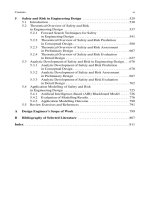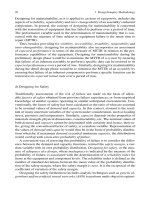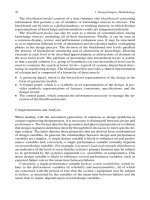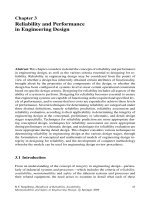Handbook of Reliability, Availability, Maintainability and Safety in Engineering Design - Part 28 pps
Bạn đang xem bản rút gọn của tài liệu. Xem và tải ngay bản đầy đủ của tài liệu tại đây (572.88 KB, 10 trang )
3.4 Application Modelling of Reliability and Performance in Engineering Design 253
Fig. 3.57 Development list options for selected PFD system
• equipmentphysicaldata such as type, make, size, mass, volume, numberof parts;
• equipment rating data such as performance, capacity, power (rating and factor),
efficiency and output;
• equipment measure data such as rotation, speed, acceleration, governing, fre-
quency and flow in volume and/or rate;
• equipment operating data such as pressures, temperatures, current (electrical),
potential (voltage) and torque (starting and operational);
• equipment property data such as the type of enclosure, insulation, cooling, lubri-
cation, and physical protection.
The technical specification document illustrated in Fig. 3.60 a utomatically formats
the technical attributes relevant to each type of equipment that is selected in the
design process. The document is structured into three sectors, namely:
• technical data obtained from the technical data worksheet, relevant to the equip-
ment’s physical and rating data, as well as performance measures and perfor-
mance operating, and property attributes that are considered during the design
process,
• technical specifications obtained from an assessment and evaluation of the re-
quired process and/or system design specifications,
254 3 Reliability and Performance in Engineering Design
Fig. 3.58 Overview of selected equipment specifications
• acquisition data obtained from manufacturer/vendor data sheets, once the appro-
priate equipment technical specifications have been finalised during the detail
design phase of the engineering design process.
The second category in the RAMS analysis list is the analysis option that enables
selected users to access the major development tasks relative to the selected system
of the section’s PFD.
The options listed in the selection box in Fig. 3.61 appear after clicking on a se-
lected system (in this case, the reverse jet scrubber), and include an analysis based
on the following major development tasks:
Equipment (technical data sheets) Tasks (maintenance/operational)
Systems (systems structures) Procedures (reliability and safety)
Process (process characteristics) Costs (parametric cost estimate risk)
Functions (physical/operational) Strategy (operating/maintenance)
Conditions (physical/operational) Logistics (critical/contract spares)
Criticality (consequence severity) Instructions (safe work practices)
The majo r development tasks can be detailed into activities that constitute the over-
all RAMS analysis deliverables, not only to determine the integrity of engineering
3.4 Application Modelling of Reliability and Performance in Engineering Design 255
Fig. 3.59 Overview of the selected equipment technical data worksheet
design but also to verify and evaluate the commissioning of the plant. These tasks
can also be applied sequentially in a RAMS analysis of process plant and general
engineered installations that have been in operation for several years.
Some of these activities include the following:
• systems breakdown structure development,
• establishing equipment technical specifications,
• establishing process functional specifications,
• developing operating specifications,
• defining equipment function specifications,
• identifying failure characteristics and failure conditions,
• developing equipment fault diagnostics,
• developing equipment criticality,
• establishing equipment performance measures,
• identifying operating and maintenance tasks,
• developing operating procedures,
• developing maintenance procedures,
• establishing process cost models,
• developing operating and maintenance strategies,
• developing safe work practices,
256 3 Reliability and Performance in Engineering Design
Fig. 3.60 Overview of the selected equipment technical specification document
• establishing standard work instructions,
• identifying critical spares,
• establishing spares requirements,
• providing for design modifications,
• simulating critical systems and processes.
The results of some of the more important activities will be considered in detail later,
especially with respect to their correlation with the RAMS theory, and failure data
that were obtained from the plant’s distributed control system (DCS) operation and
trip logs, 18 months after the plant was commissioned and placed into operation.
The objective of the comparative analysis is to match the RAMS theory, specifically
of systems and equipment criticality and reliability, with real-time operational data
after plant start-up.
Analysis of selected functions of systems/assemblies/components is mainly a cat-
egorisation of functions into operational functions that are related to the item’s
working performance,andinto physical functions that are related to the item’s mate-
rial design. The definition of function is given as “the work that an item is designed
to perform”. The p rimary purpose of functions analysis is to be able to define the
failure of an item’s function within specified limits of performance. Th is failure of
an item’s function is a failure of the work that the item is designed to perform, and
3.4 Application Modelling of Reliability and Performance in Engineering Design 257
Fig. 3.61 Analysis of development tasks for the selected system
is termed a functional failure. Functional failure can thus be defined as “the inability
of an item to carry out the work that it is designed to perform within specified limits
of performance”.
The result of functional failure can be assessed as either a complete loss of the
item’s function or a partial loss of the item’s function. From these definitions it can
be seen that a number of interrelated concepts have to be considered when defining
functions in complex systems, and determining the functional relationships of the
various items of a system (cf. Fig. 3.62).
The functions of a system and its related equipment (i.e. assemblies and compo-
nents) can be grouped into two types, specifically primary functions and secondary
functions. The primary function of a system considers the operational criteria of
movement and work; thus, the primary function of the system is an operational
function. The primary function of a system is th erefore a concise description of
the reason for existence of the system, based on the work it is required to perform.
Primary functions for the sub-systems or assemblies that relate to the system’s pri-
mary function must also be defined. It is at this level in the SBS where secondary
functions are defined. Once the primary functions have been identified at the sub-
system and assembly levels, the secondary functions are then defined, usually at
component level (Fig. 3.63). Secondary functions can be both operational and phys-
ical, and relate back to the primary function of the sub-system or assembly. The
258 3 Reliability and Performance in Engineering Design
Fig. 3.62 Analysis of selected systems functions
secondary functions are related to the basic criteria of movement and work, or shape
and consistency, depending on whether they are defined as operational or physical
functions respectively.
The third category in the RAMS analysis list is the specifications option, which is
similar to the overview option but with mo re drill-down access to the other activities
in the program, and includes specifications as illustrated in Fig. 3.64 of selected
major development tasks such as:
• Equipment specifications
• Systems specification
• Process specifications
• Function specifications
• Detailed tasks
• Detailed pro cedures
• Spares requirements
• Standard work instructions.
An engineering specification is an explicit set of design requirements to be satisfied
by a material, product or service.
3.4 Application Modelling of Reliability and Performance in Engineering Design 259
Fig. 3.63 Functions analysis worksheet of selected component
Typical engineering specifications might include the following:
• Descriptive title and scope of the specification.
• Date of last effective revision and revision designation.
• Person or designation responsible for questions on the specification updates, and
deviations as well as enforcement of the specification.
• Significance or importance of the specification and its intended use.
• Terminology and definitions to clarify the specification content.
• Test methods for measuring all specified design characteristics.
• Material requirements:physical, mechanical,electrical, chemical, etc.targetsand
tolerances.
• Performance requirements, targets and tolerances.
• Certifications re quired for re liability and maintenance.
• Safety considerations and requirements.
• Environmental considerations and requirements.
• Quality requirements, inspections, and acceptanc e criteria.
• Completion and delivery.
• Provisions for rejection, re-inspection, corrective measures, etc.
260 3 Reliability and Performance in Engineering Design
Fig. 3.64 Specifications of selected major development tasks
The specifications worksheet of selected equipment for consideration during the de-
tail design phase of the engineering design process automatically integrates matched
information pertaining to the equipment type, with respect to the following;
• equipment technical data and specifications, obtained from the technical data
worksheet and technical specifications document,
• systems performancespecifications relating to the specific process specifications,
• process p erformance specifications relating to the required design specifications,
• equipment functions specification relating to the basic functions from FMEA,
• typical required maintenance tasks and procedures specification from FMECA,
• the essential safety work instructions obtained from safety factor and risk analy-
sis,
• installation log istical specifications with regard to the required contract warranty
spares.
The specifications worksheet is a systems hierarchical layout of selected equipment,
based on the outcome of the overall analysis of specifications of selected equip-
ment for consideration during the detail design phase of the engineering design
process. The worksheet (Fig. 3.65) is automatically generated, and serves as
a systems-oriented pro-forma for electronically automated design reviews. Com-
prehensive design reviews are included at different phases of the engineering design
3.4 Application Modelling of Reliability and Performance in Engineering Design 261
Fig. 3.65 Specifications worksheet of selected equipment
process, such as conceptual design, preliminary or schematic design, and final d e-
tail design. The concept of automated continual design reviews throughout the engi-
neering design p rocess is to a certain extent considered h e re, where by the system al-
lows for input of design data and schematics by remotely located multi-disciplinary
groups of design engineers.However, it does not incorporatedesign implementation
through knowledge-based expert systems, whereby each designed system or related
equipment is automatically evaluated for integrity by the design group’s expert sys-
tem in an integrated collaborative engineering design environment.
The fourth category in the RAMS analysis list is the diagnostics option that en-
ables the user to conduct a diagnostic review of selected major development tasks
such as illustrated in Fig. 3.66:
• Systems and equipment condition
• Equipment hazards criticality
• Failure repair/replace costing
• Safety inspection strategies
• Critical spares requirement.
Typically, systems and equipment condition and h azards criticality analysis includes
activities such as function specifications, failure characteristics and failure condi-
tions, fault diagnostics, equipment criticality, and performance measures.
262 3 Reliability and Performance in Engineering Design
Fig. 3.66 Diagnostics of selected major development tasks
The following RAM analysis application model screens give detailed illustrations
of a diagnostic analysis of selected major development tasks.
Condition diagnostics in en gineering design relates to hazards criticality in the
development of failure modes and effects analysis (FMEA), and considers criteria
such as system functions, component functional relationships, failure modes, failure
causes, failure effects, failure consequences, and failure detection methods. These
criteria are normally determined at the component level but the required operational
specifications are usually identified at the sub-system or assembly level (Fig. 3.67).
Condition diagnostics, and related FMEA, should therefore theoretically be de-
veloped at the higher sub-system or assembly level in order to identify compliance
with the operational specifications, and then to proceed with the development of
FMEA at the component level, to determine potential failure criteria. In conducting
the FMEA at the higher sub-system or assembly levels only, the possibility exists
that some functional failures will not be considered, and the failure criteria will not
be directed at some components that might be most applicable for design review.
It is necessary to conduct a condition diagnostics, and related FMEA, at the com-
ponent level of the equipment SBS, since the failure criteria can be effectively iden-
tified only at this level, whereas for compliance to the required operational spec-
ifications, the results of the FMEA can be grouped to the sub-system or assembly
levels. In practice,however,thiscanbesubstantially time consumingbecause a large









